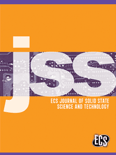
ECS Journal of Solid State Science and Technology
Scope & Guideline
Bridging Theory and Application in Materials Science
Introduction
Aims and Scopes
- Solid-State Materials:
Research on the synthesis, characterization, and application of solid-state materials, including semiconductors, dielectrics, and magnetic materials. - Nanoelectronics and Device Engineering:
Studies involving the design, fabrication, and performance of nanoscale electronic devices, including transistors, sensors, and photonic devices. - Energy Storage and Conversion Technologies:
Innovations in materials and devices for energy storage systems such as batteries and supercapacitors, as well as conversion technologies like solar cells. - Optoelectronics and Photonics:
Development and characterization of materials and devices that manipulate light, including LEDs, lasers, and photodetectors. - Chemical Mechanical Polishing (CMP):
Investigations into CMP techniques for semiconductor fabrication, focusing on material removal rates, surface quality, and cleaning processes. - Environmental and Biomedical Applications:
Research on the application of solid-state materials in environmental remediation, sensing, and biomedical technologies. - Advanced Characterization Techniques:
Utilization of advanced techniques for the characterization of materials and devices, including spectroscopy, microscopy, and computational modeling.
Trending and Emerging
- Sustainable and Green Technologies:
A growing emphasis on environmentally friendly materials and processes, including waste-derived materials for energy applications. - Flexible and Wearable Electronics:
Increased research on flexible and wearable devices, particularly in the context of health monitoring and smart textiles. - 2D Materials and Nanostructures:
A surge in studies related to two-dimensional materials like graphene and transition metal dichalcogenides, especially for electronic and optoelectronic applications. - Machine Learning and AI in Materials Science:
The application of machine learning techniques to predict material properties and optimize synthesis processes is becoming a significant trend. - Advanced Energy Storage Solutions:
Innovations in hybrid and next-generation battery technologies, including solid-state batteries and supercapacitors, are gaining traction. - Quantum Dot and Nanocrystal Research:
An uptick in research focused on quantum dots and nanocrystals for applications in photonics, sensing, and energy harvesting. - Interfacial Engineering:
Research on the engineering of interfaces in heterostructures and multilayer devices to enhance performance is increasingly prominent.
Declining or Waning
- Traditional Semiconductor Materials:
Research on bulk semiconductor materials has diminished as the emphasis shifts towards novel materials and nanostructured systems. - Basic Theoretical Studies:
While foundational theories remain important, there has been a notable decline in purely theoretical papers without experimental validation or application context. - Conventional Photovoltaic Technologies:
Studies on traditional silicon-based solar cells are becoming less frequent as interest grows in alternative energy solutions and materials. - Historical Materials Characterization:
There is a decreasing trend in studies focused on historical materials characterization techniques, as newer and more efficient methods gain popularity. - Single-Focus Studies:
Papers concentrating on a single aspect of a material or technology are declining in favor of more comprehensive, interdisciplinary approaches.
Similar Journals
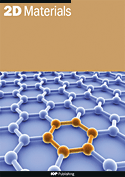
2D Materials
Leading the Charge in 2D Materials Innovation2D Materials is a leading peer-reviewed academic journal published by IOP Publishing Ltd, dedicated to advancing the field of two-dimensional (2D) materials research. Since its inception in 2014, the journal has rapidly become a primary platform for disseminating cutting-edge findings across a broad spectrum of disciplines, including Chemistry, Condensed Matter Physics, Materials Science, and Mechanical Engineering, successfully securing a top-tier quartile ranking (Q1) in these fields as of 2023. With an impressive Scopus ranking—placing it in the top 7% in Mechanical Engineering and top 8% in Condensed Matter Physics—this journal exemplifies excellence in scholarly communication. The journal offers diverse access options to cater to a global audience, underscoring its commitment to fostering collaboration and innovation within the scientific community. As researchers, professionals, and students continue to explore the vast potential of 2D materials, 2D Materials remains at the forefront, shaping the future of material science with impactful research and comprehensive reviews.
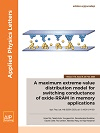
APPLIED PHYSICS LETTERS
Pioneering Research in Applied Physics Excellence.Applied Physics Letters, published by AIP Publishing, is a premier journal dedicated to the rapid dissemination of research in the dynamic field of applied physics. With an ISSN of 0003-6951 and an E-ISSN of 1077-3118, the journal has carved a niche for itself since its inception in 1962, serving as a vital forum for the exchange of innovative ideas and experimental findings. As of 2023, it proudly holds a Q1 ranking in the category of Physics and Astronomy (miscellaneous), standing at rank 11 out of 81 in Scopus, reflecting its influential role in advancing scientific knowledge with an impressive 87th percentile. The journal significantly contributes to the academic community by providing an accessible platform for both groundbreaking theoretical and applied research. Researchers and professionals alike benefit from its rigorous peer-review process and timely publication, fostering collaboration and dialogue among experts in the field. While the journal currently operates under a subscription model, its comprehensive scope encourages submissions covering all aspects of applied physics, making it an essential resource for researchers and students eager to stay at the forefront of this ever-evolving discipline.
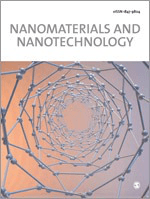
Nanomaterials and Nanotechnology
Leading the Charge in Nanotechnology AdvancementsNanomaterials and Nanotechnology is a premier journal published by HINDAWI LTD, dedicated to advancing knowledge in the rapidly evolving fields of nanomaterials and nanoscale applications. Established as an Open Access platform since 2011, the journal aims to disseminate high-quality research that provides insights into nanotechnology's manifold aspects, including biotechnology, ceramics and composites, as well as electrical and electronic engineering. With a compelling impact factor reflected in its robust Scopus rankings—placing it in the 80th percentile in Engineering and the 72nd percentile in Biotechnology—it stands as a key resource for researchers, professionals, and students seeking to stay at the forefront of innovation in materials science. The journal occupies a distinguished position in the academic community, featuring studies that explore the synthesis, characterization, and application of nanomaterials, thereby contributing significantly to scientific discourse and technological advancement in this critical area.
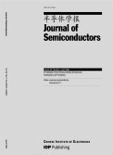
Journal of Semiconductors
Fostering collaboration in cutting-edge semiconductor research.Journal of Semiconductors, published by IOP Publishing Ltd in the United Kingdom, is a leading scholarly journal that has established itself as a premier platform for disseminating high-quality research in the fields of condensed matter physics, electrical and electronic engineering, and materials chemistry. Since its inception in 2009, the journal has featured research articles that delve into the fundamental and applied aspects of semiconductor technologies, making significant contributions to advancements in electronic, optical, and magnetic materials. The journal boasts an impressive Q1 ranking in several categories, including Condensed Matter Physics and Electronic, Optical and Magnetic Materials, reflecting its influential role in shaping contemporary research. With a dedicated audience of researchers, professionals, and students, it aims to foster collaboration and innovation in this dynamic field. Although it operates under a traditional access model, the journal offers various publication options that ensure the visibility and impact of its articles. Through its rigorous peer-review process and commitment to excellence, the Journal of Semiconductors continues to be an invaluable resource for those seeking to stay at the forefront of semiconductor research and technology.
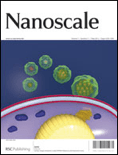
Nanoscale
Connecting Global Minds in Nanoscience.Nanoscale is a premier academic journal published by the Royal Society of Chemistry, dedicated to advancing the field of nanoscience and nanotechnology. With both its ISSN (2040-3364) and E-ISSN (2040-3372) ensuring wide accessibility, the journal is renowned for its high-impact research contributions, reflected in its impressive 2023 Impact Factor and prestigious Q1 ranking in both Materials Science (Miscellaneous) and Nanoscience and Nanotechnology categories. Since its inception in 2009, Nanoscale has fostered a collaborative platform where leading researchers from around the globe share their innovative findings across a multitude of topics spanning from material synthesis to applications in nanotechnology. The journal not only serves as a valuable resource for professionals, researchers, and students but also actively engages the academic community in discussing emerging trends, thus shaping the future of nanoscience. Situated in the heart of the UK at Thomas Graham House, Science Park, Milton Rd, Cambridge CB4 0WF, Nanoscale remains a key publication for those looking to keep abreast of the latest breakthroughs in an ever-evolving field.

PHYSICA STATUS SOLIDI B-BASIC SOLID STATE PHYSICS
Unveiling the Secrets of Electronic and Magnetic MaterialsPHYSICA STATUS SOLIDI B-BASIC SOLID STATE PHYSICS, published by Wiley-VCH Verlag GmbH in Germany, is an esteemed journal within the condensed matter physics sphere, covering pivotal advancements in basic solid state physics. With a rich history dating back to 1961, it serves as a scholarly platform for researchers, professionals, and students alike, providing insights into the fundamental properties and applications of electronic, optical, and magnetic materials. The journal currently holds a respectable Q3 ranking in both Condensed Matter Physics and Electronic, Optical, and Magnetic Materials as of 2023, indicating its impactful contributions to these fields despite its competitive landscape. While it does not offer open access, its comprehensive research findings are critical for those engaged in innovative material science research. With a convergence period extending to 2024, PHYSICA STATUS SOLIDI B continues to play a significant role in facilitating knowledge exchange and fostering advancements in solid state physics.

ADVANCED FUNCTIONAL MATERIALS
Connecting Researchers to the Future of Materials ScienceADVANCED FUNCTIONAL MATERIALS is a leading journal published by WILEY-V C H VERLAG GMBH, prominently recognized in the fields of biomaterials, chemistry, condensed matter physics, and materials science. With an impressive impact factor and a distinguished position in the Q1 quartile across multiple categories including nanoscience and nanotechnology, this journal serves as a vital platform for researchers and professionals committed to innovating in functional materials. Since its inception in 2000, ADVANCED FUNCTIONAL MATERIALS has published high-quality peer-reviewed articles that push the boundaries of materials science, exploring new frontiers in electronic, optical, and magnetic materials. The journal's dedication to open access ensures that its groundbreaking findings are readily available to a global audience, fostering collaboration and knowledge-sharing among scholars and practitioners in the field. For those seeking to stay at the forefront of materials research, ADVANCED FUNCTIONAL MATERIALS is an essential resource.

npj 2D Materials and Applications
Unveiling the Future of Materials at the Nanoscalenpj 2D Materials and Applications is a premier, open-access journal within the NATURE PORTFOLIO, dedicated to advancing the knowledge and applications of two-dimensional materials. Launched in 2017 and published from the United Kingdom, this journal quickly established itself as a key resource in its field, holding the prestigious Q1 quartile ranking across multiple disciplines, including Chemistry, Condensed Matter Physics, and Materials Science. With an impressive focus on innovative research and interdisciplinary applicability, npj 2D Materials and Applications addresses the scientific community's need for rapid dissemination of cutting-edge findings, fostering collaboration, and inspiring new applications in mechanical engineering and materials science. Researchers, professionals, and students engaged in the study and development of two-dimensional materials will find this journal an invaluable asset, offering a platform for their contributions to a rapidly evolving and transformative area of research.

ACS Applied Electronic Materials
Advancing Knowledge in Applied Materials ScienceACS Applied Electronic Materials, published by the American Chemical Society, is a prominent journal in the field of applied materials science, with a particular focus on electronic, optical, and magnetic materials. Established in 2019, this journal has quickly risen to prominence, achieving a 2023 ranking of Q1 in both Electronic, Optical and Magnetic Materials and Materials Chemistry, as well as Q2 in Electrochemistry, reflective of its high-quality contributions and significant impact within the scholarly community. With an impressive Scopus rank of #22 in Electrochemistry, #59 in Electronic, Optical and Magnetic Materials, and #75 in Materials Chemistry, ACS Applied Electronic Materials serves as an essential resource for researchers, professionals, and students seeking to explore innovative advancements in the field. While the journal is not open access, it offers robust subscription options and aims to foster the dissemination of cutting-edge research articles, reviews, and technical notes that contribute to the understanding and application of electronic materials in various technological contexts. As a platform for pioneering research and cross-disciplinary dialogue, this journal is indispensable for anyone invested in the future of materials science.

Journal of Ovonic Research
Catalyzing Innovations in Surface and Coating Technologies.Journal of Ovonic Research is a distinguished publication dedicated to advancing the fields of electronic, optical, and magnetic materials. Published by VIRTUAL CO PHYSICS SRL, this journal offers a platform for researchers to share innovative findings and developments that push the boundaries of technology and materials science. With an ISSN of 1842-2403 and an E-ISSN of 1584-9953, it provides an important service to the academic community, particularly within Romania and beyond. Despite its recent inception in 2011, the journal has gained traction in the academic landscape, reflecting a Q4 quartile ranking in crucial categories such as Electronic, Optical and Magnetic Materials, as well as in Physics and Astronomy. The Scopus rankings further underscore its positioning, ranking within the 25th to 37th percentile across various disciplines, making it a valuable resource for professionals and students alike. Although the journal currently operates on a non-open access basis, it remains committed to exploring the latest advancements in materials science, encouraging interdisciplinary collaboration and fostering a deeper understanding of surface, coating, and film technologies. As the field evolves, Journal of Ovonic Research stands as a beacon for scholarly communication, bridging the gap between research and practical application.